top of page
Stocks, handguards & hardware
The stock and handguard classification on this page is based upon their construction elements description and their changes. Each factory, during different production periods, had its own unique combination of features. A correct conclusion about a stock's production period can be made after detailed inspection of all the aspects listed below.
Stocks soaking and laquering
Collectors have always had a lot of controversial discussions about M91 and M91/30 stocks finish methods used by the Soviets. During the 1930's-1940's, the Tula and Izhevsk factories stock finish had little difference in details. The basic wood that was used for stock production was birch (walnut was rarely used for sniper rifle stock production). Birch was very sensitive to moisture absorption and required a good protective finish. The basic scheme of stock production from birch wood was: At first stocks were painted with a stain, then they were soaked with a compound that penetrated into the wood structure (creating a protective barrier). Afterwards, they were covered with lacquer and varnish. Walnut stocks were not painted with stain.
Very early M91/30 stocks were finished like late M91 stocks - the stock was "painted" with a composition that was made from:
- decoction of the white (yellow) sandal wood (Santalum album) in water with addition of potassium carbonate;
- decoction of blue sandal wood (Haematoxylum campechianum) in water with addition of potassium carbonate;
Those decoctions were made separately, later they were merged together and Iron(II) sulfate was added. The darkness of the color was regulated with Iron(II) sulfate.
Since at least the mid 1920's stocks were soaked with hot BLO (the earlier period will require deeper research). For the final finish shellac lacquer and varnish were used. In the late 1920's a new wood stain was introduced, made on the base of a so called "Cologne earth". Both wood stains, sandal based and "beizen", were made from imported components and were used depending on the available supply. Stocks that are painted with a sandal wood composition are light colored with a yellow tint, stocks painted with "beizen" wood stain have a brown tint.
1924 Tula dragoon M91 stock, sandal based wood stain

1924 Izhevsk dragoon M91 stock, sandal based wood stain
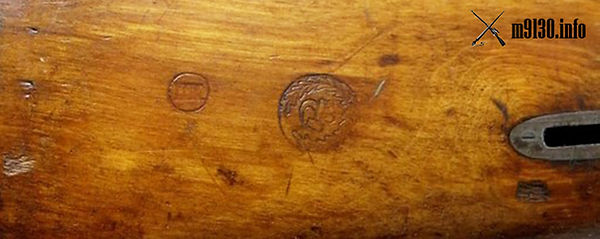
1924 Tula infantry M91 stock, sandal based wood stain
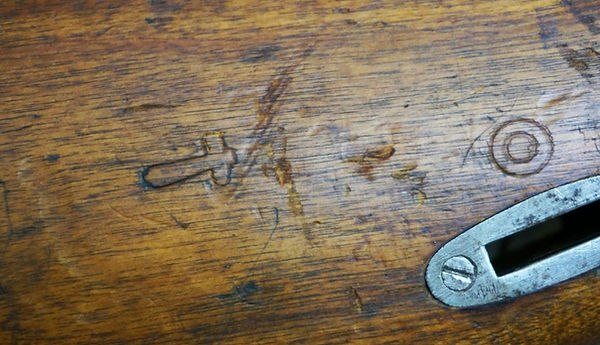
1929 Tula dragoon M91 walnut stock, sandal based wood stain

1928 Tula dragoon stock, “beizen” wood stain

Sandal wood, "beizen" wood stains and shellac components were very expensive. They were not produced within the borders of the USSR, production depended on import supplies. Because of that, since the 1920's the Soviets made an intensive search for replacements. In 1930 the sandal wood stain was replaced with tar ("деготь" in Russian, different types were used), shellac finish and BLO were still used because their replacement was not found. Some experiments were made with different components, sometimes it is difficult to verify what components were used for the finish of a particular stock.
1930 Izhevsk dragoon M91 stock. Unclear which wood stain was used - color is too brown for sandal wood stain, and too light for a tar. Courtesy of Matt Darnell


1932 Tula stock painted with tar.

1933 Izhevsk stock painted with tar.
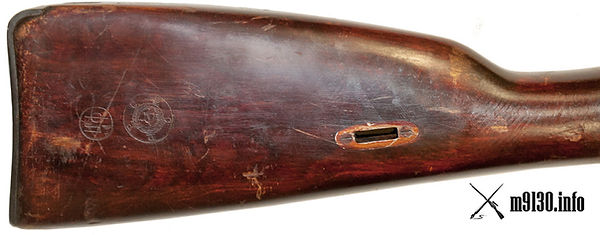
In the early 1930's the use of tar wood stain was stopped, stocks were finished with a "beizen" wood stain. It's unclear when, but in the 1930's Soviets managed to replace the imported "Cologne earth" with a chemically synthesized equivalent, this significantly improved supply.
A large number of trial soakings and lacquers (together with different, not only birch, wood types) were tested in the 1930's. However, up to the end of the 1930's no major changes were introduced into production - birch stocks were soaked with BLO, painted with a "beizen" wood stain and finished with shellac lacquer and varnish.
* In mid 1934 the Izhevsk factory issued a very small number of beech stocks. These stocks have a visible beech structure and are light colored compared to birch stocks - they were not painted with a "beizen" stain.
1934 Izhevsk produced beech stock. Postwar refinished, found on a regular refurb


Typical mid/late 1930's Izhevsk stocks


Side-to-side comparison of stocks from different manufacturers can show some differences in color and the shine of the finish, but basically, only the mentioned components were used in mass production during that period.
In 1936 a new standard for M91/30 production was adopted, this regulated M91/30 production operations - "Technical conditions #1525". They contained list of neccessary operations and requirments for produced parts, they markings, finish, interaction. According to "Technical conditions #1525", dried stock blanks (6-8% humidity) were polished, painted (with "beizen" stain), soaked wit BLO or tar, and covered with 8 layers of shellac lacquer and varnish. Two wood types were allowed to be used - birch and walnut.
In 1938 new technical conditions #2088 for M91/30 stocks production were adopted, but no change to the finish was introduced. Even though the technical conditions for production were the same for both factories, final products looked a little different, the finish on stocks from different factories can vary from shiny to matte. Technical conditions had notes that all stocks are finished similar to "established samples", but both factories adopted their own "samples", that generally matched finish methods and stages from technicla conditions, but were different is smalled details not mentioned there.
Typical mid/late 1930's Tula stock. Courtesy of Ryan Elliott

In 1940 Izhevsk replaced the shellac lacquer/varnish with nitrocellulose VK-1 lacquer/varnish. BLO, soaking/tar were still used. In the very beginning of production the factory had some problems with finish quality, it was flaky, but then the experiments showed that application of vaseline oil (translation from Russian, in English - "Liquid paraffin") improved the quality of the VK-1 finish., and it was introdusced into production
1941 Izhevsk stocks with VK-1 laquer finish


In 1941, after war started, the Izhevsk factory significantly increased rifles and carbine production. Their construction was simplified, stock finish was changed. Multiply lacquering with VK-1 (according to prewar standards) was replaced with double, or even single. BLO, in case it was not available, was replaced with ersatz substitutes - in 1942 even raw oil soaking (with addition of creosote) was used.
1942 Izhevsk factory #74 stock with ersatz soaking

In the most difficult periods lacquering was not used at all. For example, the majority of stocks at the newly created factory #536 NKV in Tula, which started production in February 1942, were issued without a lacquer finish. However, because of much lower production the Tula factory was able to use BLO soaking.
1942 Tula factory #536 NKV stock without VK-1 laquer finish

1943 factory #74 stock with unidetified soaking and without laquering

1942-1943 factory #74 stock finshed with laquer

In 1943 the supply situation became much better and the use of BLO substitutes was stopped. In the end of 1943 triple lacquering returned. The finish was not changed until the end of M91/30 and M44 production in the late 1940's .
It is widely believed that shellac lacquer was used during postwar refurbishment. But repair documentation show only two lacquers - VK-1 (postwar abbreviation is НЦ-5119), and MCH-52 lacquer that was sprayed when stock was placed to the electrostatic field. Flaky finish on postwar refurbished rifles is the result of application issues during the refurbishment process, or use of old VK-1 lacquer.
Flaky postwar VK-1 finish. Issue of the application or old laquer.

Stock parts
Basic elements of stocks, that roughly allow us to estimate its production period, are sling slots. The launch of the M91/30 production in 1931 did not impact the stock construction - it was identical to late 1920's dragoon M91's. 1930's produced M91/30 stocks had screwed inserts into the sling slots (escutcheons). Identical construction was used by Tula and Izhevsk factories. The shape and size of the inserts were changed at least twice in 1930's.
Screwed in sling slot inserts

The Tula factory #314 NKV stopped M91/30 production in 1940 and switched to SVT-40 production, Izhevsk factory #74 NKV had no major changes in the sling slot construction until the beginning of WWII. In the autumn of 1941, a large amount of simplifications were introduced to the M91/30 production in Izhevsk. Some of these were related to stock production. Screwed in sling slot inserts were eliminated, the front sling slot got a stamped insert made from 0.024" steel, the rear sling slot remained without an insert. Only this small change allowed for the saving of a few tons of metal monthly, it also freed almost 100 workers and 20 machines. During the transitional production period in Autumn 1941, some stocks have "transitional" features - for example, a screwed sling slot insert in the front and no insert in the rear, or vice versa.
Stamped insert in the front and no insert in the rear.
Izhevsk factory 1941-1944 production.


In 1942 production of M91/30 rifles was restored at the newly created factory #536 NKV in Tula. In 1942 and early 1943 this factory still used prewar style screwed in sling slot inserts and did not produce simplified version, like was done in Izhevsk.
1942-1943 factory #74 stock finshed with laquer

1943 Tula stock with screwed in sling slot inserts. Re-lacquerd postwar by a Soviet repair depot. Courtesy of Peter Malik

The Tula factory still looked for a cheaper alternative, in early 1943 they created their own design of stamped sling slot inserts that were installed without screws. They were immediately introduced into production. The factory continued to produce stocks with these inserts up to the end of the production in late 1944.
1943 Tula stock with stamped sling slot inserts. Re-lacquerd postwar by a Soviet repair depot. Courtesy of Peter Malik


The main Artillery directorate of the Red Army highly recommended that the Izhevsk factory introduce into production sling slot inserts designed in Tula, but the factory administration was strongly against this because of the higher expenses compared to the sling slots used in Izhevsk. After a long dispute the Izhevsk factory agreed to use sling slot inserts in the rear at lest on sniper rifle stocks, but they used their own design - similar to the front insert.
1943 - early 1944 Izhevsk PU sniper rifle stock with insert in the rear

In mid 1944 the main Artillery directorate prevailed, the Izhevsk factory started to use full metal inserts on both sling slots - front and rear. Since very late 1945 to early 1946 these inserts were used on M44 carbines and seldom on regular M91/30 rifles. Starting in 1944 the percentage of stocks produced with a toe splice rapidly increased. Details about toe splices will be provided below.
Izhevsk stock with stamped inserts (mid 1944-1947 sniper rifles, late 1945-1948 M44 carbines).
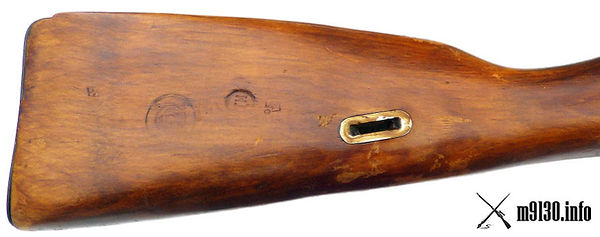

1946 M44 stock with toe splice.
Photo courtesy of Phillip Gorny

It should be mentioned that since late 1941 Izhevsk stocks had an additional notch above the cleaning rod, it was useful in preventing the clogging of the cleaning rod retaining nut with mud - the mud was pushed by the cleaning rod into the notch
On the top - prewar stock, on the bottom - wartime Izhevsk stock with notch.

None of these features were used by the Tula factory in 1942-1944. They were used on many replacement stocks that were produced by repair depots of the Main Artillery directorate.
It is commonly believed that grooves (cutouts) for rear barrel bands release are postwar addition. They were introduced into production by both factories in 1939 (officially adopted and included into the drawings in December 1937). In 1940 drawings were changed, the size of the cutout was increased. However, this was introduced into production only by Izhevsk because the Tula factory already stopped M91/30 production by this time
Pre 1939 stock. No cutouts

1939-1940 Tula stock. Courtesy of Ryan Elliott.

1940-1941 Izhevsk stock with increased cutouts.

1940-1941 Izhevsk M38 carbine in action.

After some wartime simplifications were introduced into production by the Izhevsk factory in 1941, cutouts for barrel bands release were eliminated, late 1941-1945 Izhevsk stocks do not have these cutouts. In late 1945-early 1945 cutouts returned into production, but the shape was changed, it became more oval.
It is interesting that the shape of the cutout can be seen in the late 1930's drawings (in a so called "list of changes") - some images show a rifle with a similar cutout, but these images are not related to cutout itself. The same list of changes adopted round cutouts. It looks like that this shape was discussed, but not adopted.
Izhevsk factory 1946-1948 cutout for barrel band release.

In 1942-1944 the Tula factory continued to use cutouts made according to the 1937 drawings (smaller shape), all 1941-1944 Tula stocks had them.
Cutout on a1942 Tula stock.

Another feature that can help to estimate the stock production period is the shape of finger grooves in the middle of the stock. All Tula stocks made before mid 1931 (also earlier M91's and dragoon M91's) have grooves with rounded corners. In mid 1931 the factory switched to oval shape ends, similar to the Izhevsk pattern (Izhevsk used such a shape since the mid 1890's).
1891-1931 Tula stock finger grooves.

1890's-1948 Izhevsk and 1931-1944 Tula stock finger grooves.

Because of the heavy use in the field during service, many rifles required stock replacement. In the pre-1941 period replacement stock were produced only by factories that produced complete rifles. During war, factories were overloaded with production of complete rifles and were not able to produce the necessary quantity of replacement stocks (however, some quantity was produced). The main Artillery directorate decided to start stock production at repair depots, some of them were well equipped with woodworking machinery.
Stock were issued by a number of manufacturers, they mainly have wartime Izhevsk pattern with simplified sling slot inserts (however, there is a big variety of configurations, and it is not possible to cover them all in a brief description on this page). The majority of them have no markings that allow for the identification of the manufacturer and are more rough compared to factory made stocks. A few repair depots marked their stocks with their emblem (on the right side of the buttstock) - stocks with a "25 in star" marking (Central Artillery armament base in Omsk), and with a crossed box marking (Arsenal #1, Donguzskaya railway station, since 1944 - Balakleya) are quite common. Birch was used as the main wood for production, but sometimes depots produced beech stocks, beech wood was allowed to be used starting in 1943.
Wartime pattern stock, made by Arsenal #1
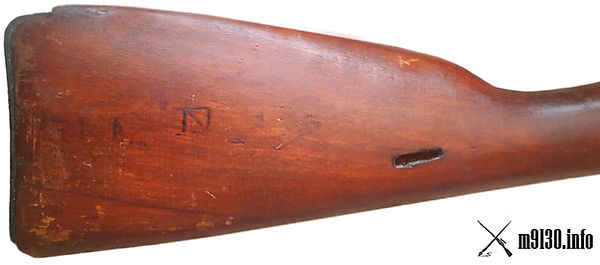
Poorly stamped "25 in triangle" markings on the buttstock.

Rough wartime replacement stock made by an unknown repair depot.



Since the late 1940's replacement stocks were made by only one repair facility - Arsenal #1 in Balakleya, Ukrainian SSR. It is widely believed that the "box with a cross line" is "refurbishment marking". Actually, Soviets did not use "refurbishment markings" in the meaning of the fact that only refurbishment took place. All markings of this type are actually repair depot logos (trademarks). The locations where they were stamped are mentioned in repair documentation for each weapon type. In the case of M91/30's and carbines, refurbished postwar, repair depot markings that identify where a rifle/carbine was refurbished was stamped near the factory marking (mainly on the barrel shank, sometimes on the front end of the receiver).
But repair depots also produced some accessories and rifle/carbine parts. They were also stamped with the repair depot marking. In this case it indicates that the item was produced by a particular repair depot. So a "box with cross line" at the buttstock of the majority of the stocks indicates that the it was produced by Arsenal #1. However, Arsenal #1 is the only recorded depot that rarely placed its marking on some heavily refurbished/repaired stocks from other manufacturers. Sometimes traces of the Tula and Izhevsk factory markings can be found near a "box with cross line" marking, this means that the stock was repaired by Arsenal #1.
The majority of postwar stocks made by Arsenal #1 were made from birch, rarely from beech. Postwar stocks had full metal sling slot inserts (factory #536 NKV in Tula type), stamped barrel band slings and oval cutouts forthe barrel band release (sometimes similar shape cutouts were added to the stocks of other manufacturers during refurbishment). Some were with a toe splice, some were without. Details about stocks with a toe splice will be provided below.
Postwar replacement stock made by Arsenal #1. Birch wood. Type with toe splice.


Early postwar (with А.П. in box acceptance) replacement stock made by Arsenal #1. Birch wood. Type without a toe splice.

Beech stock made by Arsenal #1.

There have been a lot of discussions about laminated stocks. Soviets tested stocks made from laminated wood since the late 1930's, but only a few trial stocks were made and the tests were unsuccessful. Until 1945 there was no production of laminated stocks (despite some online sources claiming otherwise). Mass production of laminated stocks started in the mid 1950's (trials were made in very late 1940's - early 1950's), these were birch laminated stocks made by Arsenal #1. These stocks had wrist bolts for preventing cracks in this area. Wrist bolts were also used during repairs of regular stocks (more details are provided in the section about repair depots modifications)
Birch laminated stock with wrist bolt. Mid 1950's and later production. Arsenal #1.

There is a belief about the existence of "early" Soviet laminated stocks from beech wood (they exist only in M38 and M44 carbine stocks configuration). The problem is that there is no information (in factory and Soviet repair depot documentation) about them. Construction is atypical to soviet stocks - beech was very rarely used in soviet stocks, barrel band springs are riveted instead of welded, sling slot insert are blued (sometimes they are not) and so on. So far there is no evidence that they are soviet produced. This website is not a place for unconfirmed theories, but a small exclusion is possible - it is very plausible that these stocks were made from 98k carbine stock blanks postwar in the Soviet occupation zone as a reparation. This also explains why these stocks do not exist in M91/30 configuration - 98k stock blanks were too short for them. However, please did not accept this version as completely correct, merely a theory
Beech laminated M38/M44 stock

Riveted barrel band springs, typical to beech laminated stocks.
Photo courtesy of Dave Phillips.

Previously toe splices in stock construction were mentioned. They can be original to the stock (a stock was issued with it) or they can be a repair insert because of damage the the area. M91/30 drawings/instructions were updated with the possibility of toe splice production since 1938. Technical conditions #2066 allowed producing up to 20% of stocks with a toe splice, in limited numbers these stocks were produced before the war. During wartime their number was increased.
This modification allowed using shorter (1185 mm instead 1425 mm) and more narrow (185 mm instead of 200 mm) stock blanks. Izhevsk and Tula made spliced stocks had a V shape joint, repairs made by the Main Artillery Directorate depots, and repair depots had dovetail or U-shape (arc) joints. Factory toe splice is easy to spot - it is longer and ends under the sling slot. Starting in 1946 the majority of stocks in M44 production were issued with a toe splice.
However, dovetail joints did not appear out of nowhere. Judging from surviving samples, at least in 1924-1925 the Izhevsk factory used toe splice with a dovetail joint in production. Considering the fact that such a method was not included into the drawings in that period, this was a trial feature made in limited numbers. Factory dovetail joint is still longer that repair depot made - the main goal of this feature on factory issued stocks was to make possible the use of narrow stock blanks, that's why a longer joint was required

On the left - Izhevsk factory V-shape joint, on the right - dovetail joint on a postwar Arsenal #1 produced birch laminated stock.
On the the top - longer Izhevsk factory toe splice, on the bottom - shorter splice on a postwar Arsenal #1 produced solid wood birch stock.


1924 Izhevsk dragoon stock with a factory made toe splice (dovetail joint).
Photo courtesy of Yurij Shevchenko.
Handguards
During the whole production period the M91/30 rifle had a single type of handguard, with a metal end on both sides. However, there were few production modifications. Generally, hanguards of this type were used on M91 dragoons - it was designed in 1924, and introduced into production in 1925 in Izhevsk and in 1926 in Tula
Typical M91/30 stock handguard.

According to the very first M91/30 drawings, handguards were made from birch or walnut and had brass caps, locked with brass or copper rivets (both were allowed). This production pattern was the only one used by both factories up to the Autumn of 1941, when the Izhevsk factory introduced some simplifications to the production. Copper rivets were typical to Izhevsk (brass rivets are unusual to Izhevsk), while Tula used both copper and brass rivets. In the Autumn of 1941 Izhevsk brass caps on the handguard were replaced with steel caps (blued), they were stacked instead of riveted. Those changes made production much cheaper. Izhevsk used this pattern up to the end of the production in 1942.
The newly created factory #536 in Tula, during 1942 and 1943, used the prewar pattern - brass caps with brass rivets. However, in 1942, their machining was much less accurate compared to prewar handguards. In 1943 the factory switched to the stacked steel caps (similar to the Izhevsk pattern) and used them up to the end of the production in 1944. Some postwar replacement handguards, made by repair depots, had stacked brass caps. Odd varieties, like aluminum caps, aluminum caps with rivets, are repair depot production. M38 and M44 carbines had the same pattern handguard caps as the M91/30 rifle made by the particular factory at that moment.
On the left - prewar handguard with brass caps and copper (brass) rivets, in the middle - with steel stcked caps, on the reight - with brass stacked caps

Rough Factory #536 (Tula) 1942 produced handguard.

Hardware
One of the main four parts that were changed in M91/30 production compared to late dragoon M91's were barrel bands (The other three parts were the front sight, rear sight and bayonet). Instead of solid barrel bands, barrel bands with a button connection, designed by I. Fedortsev, were introduced. These bands were used until 1934 in Izhevsk and up to 1935 in Tula.
Solid M91 dragoon bands

Bands with a button connection

In late 1932 the Izhevsk factory created new design of the barrel bands, without a button connection. It was submitted for trials and was introduced into mass production in late 1933 in Izhevsk. Izhevsk factory completely switched to the new type in 1934, Tula - in 1935.
Spring barrel bands without a button connection

Nosecaps have two production variations - one is a milled type, the other is stamped. Milled type is the earlier variation, but for a long time period both types were produced together. The stamped type was designed by the Tula factory in the mid 1920's, after this Tula produced only the stamped type. The Izhevsk factory produced the milled type until mid 1941, they switched to the tamped type only in the Autumn of 1941.
On the left - stamped nosecap, on the right - milled

Stamped and milled nosecaps, marked with a pre-1928 Tula "hammer" marking.

In the Autumn of 1941 the Izhevsk factory introduced a few simplifications into production that were related to stock hardware. Barrel band springs were simplified (they were made bu stamping instead of milling), cleaning rod retaining nut and buttplate (holes were punched instead of drilling) were also simplified. None of those changes were used by the Tula factory in 1942-1944, it still used prewar patterns in the production of these parts
On the left - stamped barrel band spring, on the right - milled barrel band spring

Wartime/postwar simplified Izhevsk factory cleaning rod retaining nut


Prewar pattern cleaning rod retaining nut
On the top - buttplate with a drilled hole, on the bottom - with a punched hole.

bottom of page
